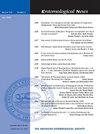斑点斑斑斑蝶巢(上)被小黄蜂(膜翅目:小黄蜂科)侵占
IF 0.3
4区 农林科学
Q4 ENTOMOLOGY
引用次数: 2
摘要
泰勒(1939年)最初报道称,南部的黄夹克是一种兼性的临时社会寄生虫,他在Vespula vidua(Saussure)的巢穴中发现了一只女王。后来,Mac Donald和Matthews(1975年、1984年)发现斑腹蛛是斑腹蛛(du Buysson)的一种常见兼性寄生虫。这些作者还提到了一个案例,一窝黄毛猪笼草被鳞片猪笼草女王侵占。鳞片胡蜂的其他宿主包括德国胡蜂(Fabr.)和大得多的胡蜂(Vespa crabro L.)(Greene,1991)。我们现在报道了秃顶大黄蜂,Dolichovespula maculata(L.),作为一种新的属间寄主。本文章由计算机程序翻译,如有差异,请以英文原文为准。
A Nest of Dolichovespula maculata (l.) Usurped by Vespula squamosa (Drury) (Hymenoptera:Vespidae)1
The southern yellowjacket, Vespula squamosa (Drury), was initially reported to be a facultative temporary social parasite by Taylor (1939), who found a queen in a nest of Vespula vidua (Saussure). Later, Mac Donald and Matthews (1975, 1984) found Vespula squamosa to be a frequent facultative parasite of Vespula maculifrons (du Buysson). These authors also mentioned one case of a nest of Vespula flavopilosa Jacobson usurped by a queen of Vespula squamosa. Other hosts of Vespula squamosa include Vespula germanica (Fabr.) and the much-larger hornet, Vespa crabro L. (Greene, 1991). We now report on the Baldfaced Hornet, Dolichovespula maculata (L.), as a new intergeneric host for Vespula squamosa.
求助全文
通过发布文献求助,成功后即可免费获取论文全文。
去求助
来源期刊

Entomological News
生物-昆虫学
CiteScore
1.10
自引率
25.00%
发文量
17
期刊介绍:
Contributions are accepted on any of the aspects of systematics and taxonomy of insects. This includes: taxonomic revisions, phylogenetics, biogeography and faunistics, and descriptive morphology of insects. Taxonomic papers describing single species are acceptable if such a study is sufficiently justified, however, comprehensive studies that provide a comparative, integrated study of insect systematics and taxonomy will get priority.
 求助内容:
求助内容: 应助结果提醒方式:
应助结果提醒方式:


